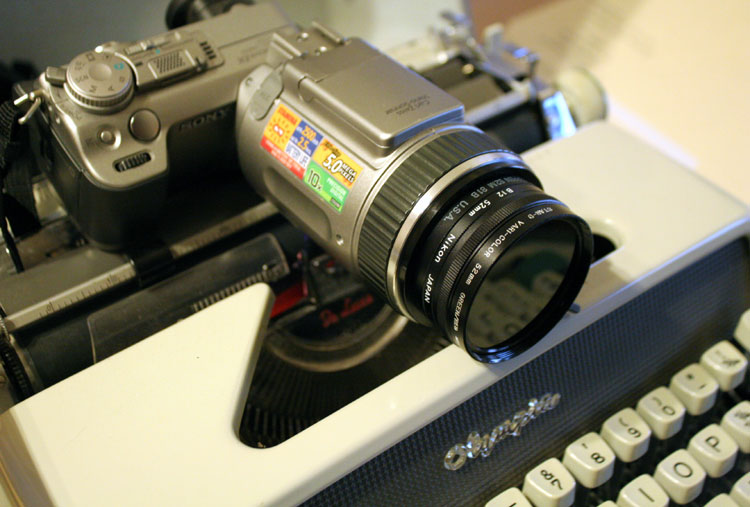
Sony DSC-F707 with my McGuyvered filter experiment to allow daylight infrared shooting. Looks good in the viewfinder, but can’t really tell until I get a Memory Stick so I can actually take pictures. :D
UPDATE: My memory stick came in this morning, and I was able to take some pics using my jury-rigged filter stack. Results are interesting! There’s some visible light frequencies getting through the stack, and having 5 very dark bits of glass in front of the lens doesn’t result in great sharpness, but it works!
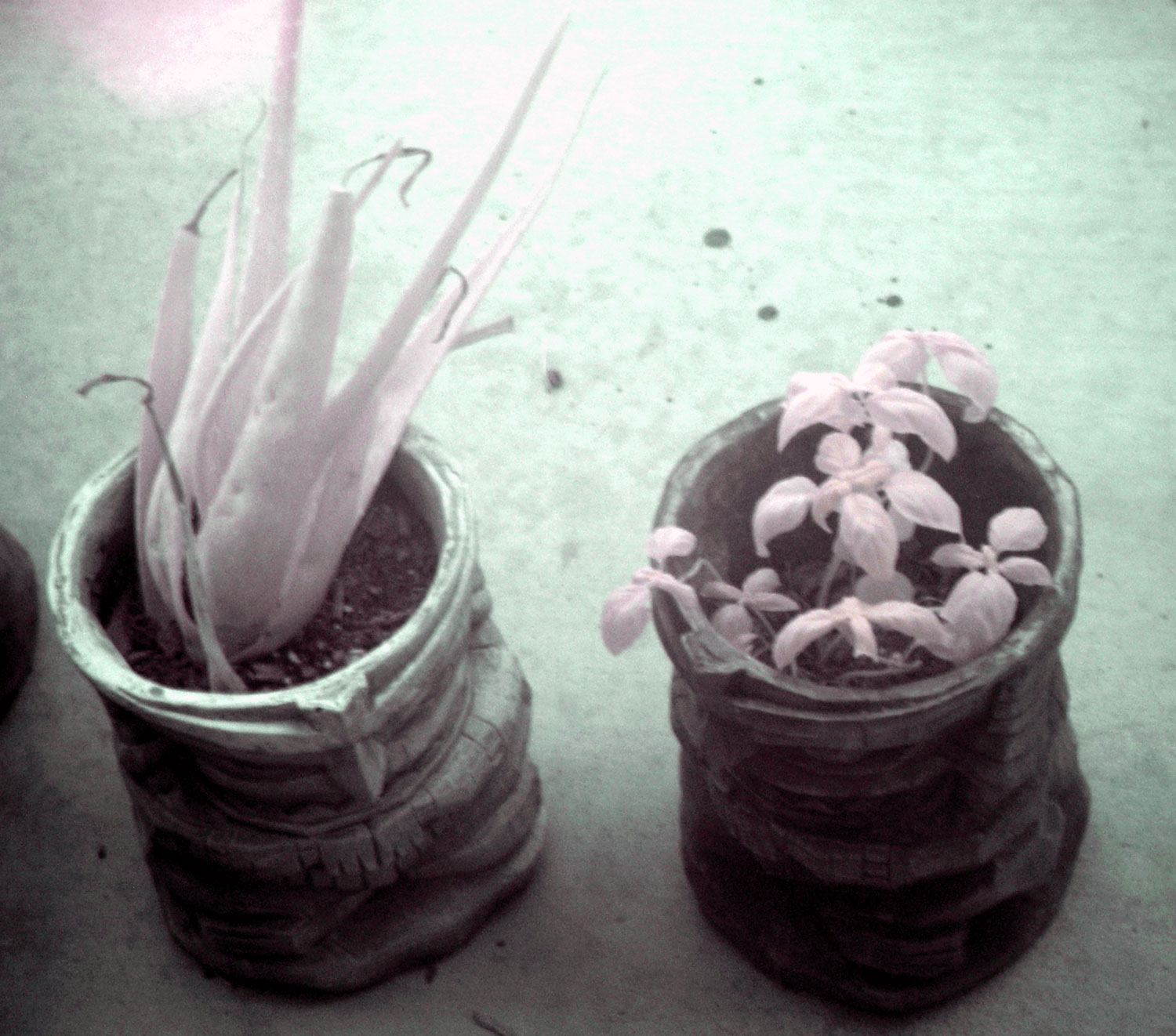
This aloe vera plant has mottled, spotted skin which is actually transparent to IR. What you’re seeing is the IR light reflected by the chlorophyll beneath the plant’s skin.

This one is shot without the filter stack in total darkness illuminated only by the IR emitter. This is the kind of sharpness I’m looking for, which I will probably only get using the proper filters.
You can click to embiggen these pics. I uploaded them at about twice the size of the pics I normally post.
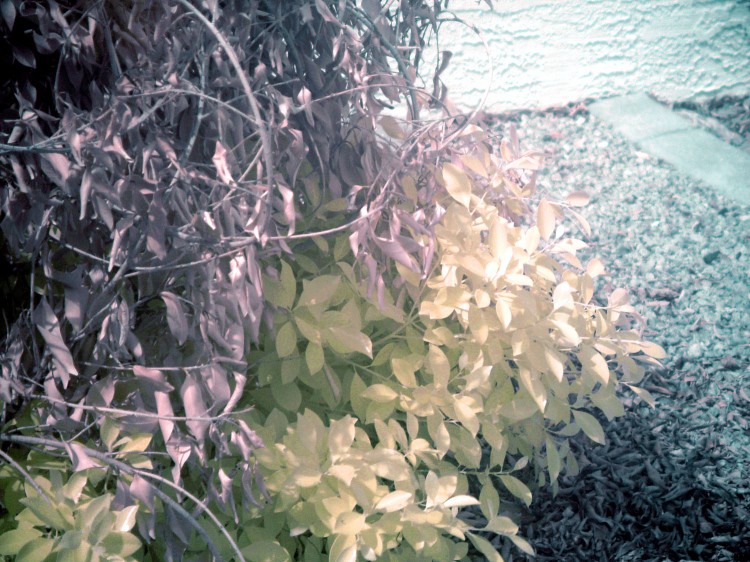
This shot of a bush that got halfway killed by frost last winter shows the striking difference between living and dead things when viewed in IR.
All in all, first experiment is mostly successful, I think. I do need the proper filters, but since I’m broke, I’ll be doing more experiments using stuff I actually have around the house. I’ve read somewhere that old floppy disks can be used as poor man’s IR passthrough filters – I’ll have to try that. Also I think I still have some old stripper’s rubylith sheets around which I might try out. Fun, fun, fun! :D
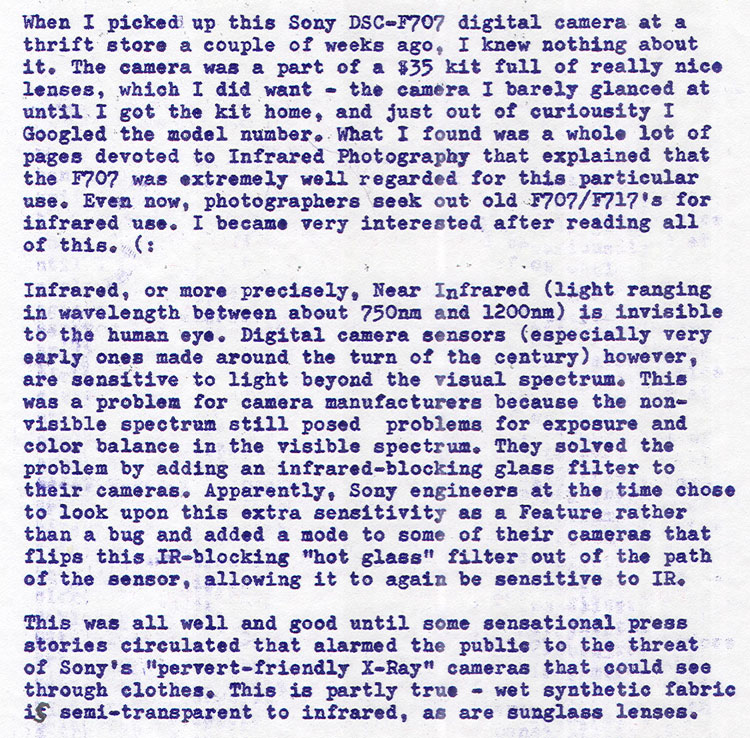
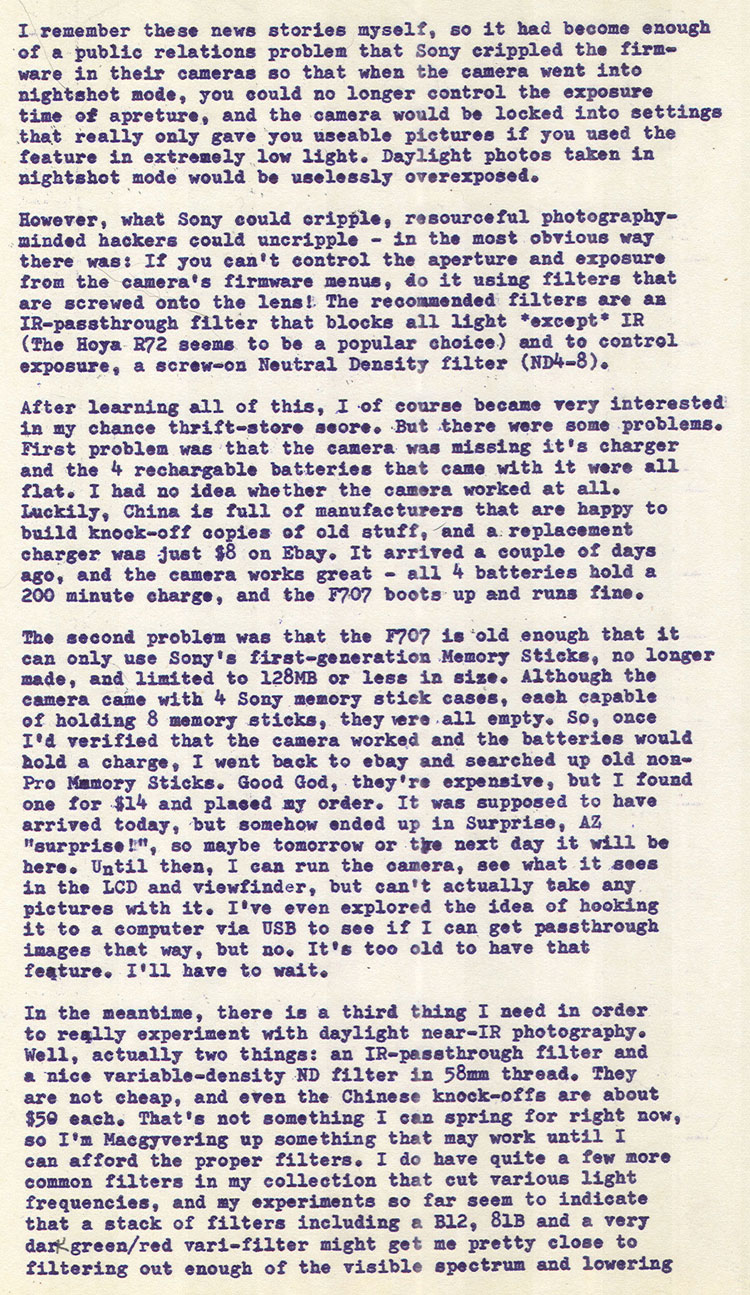

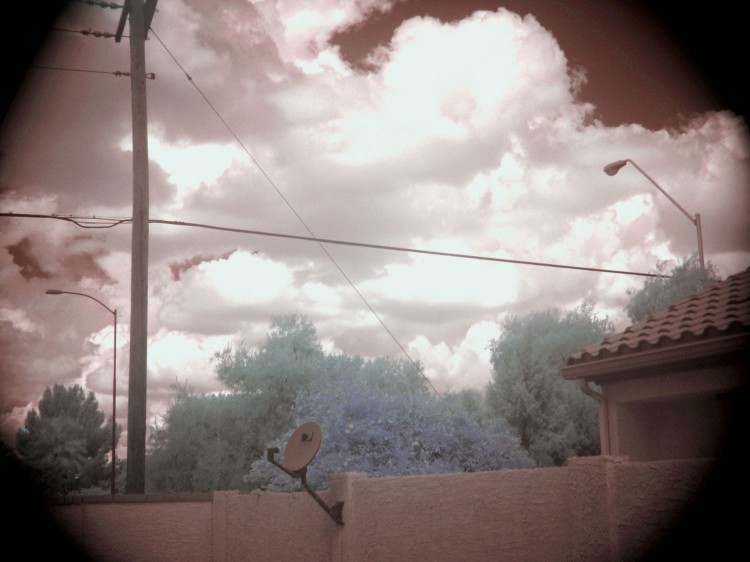
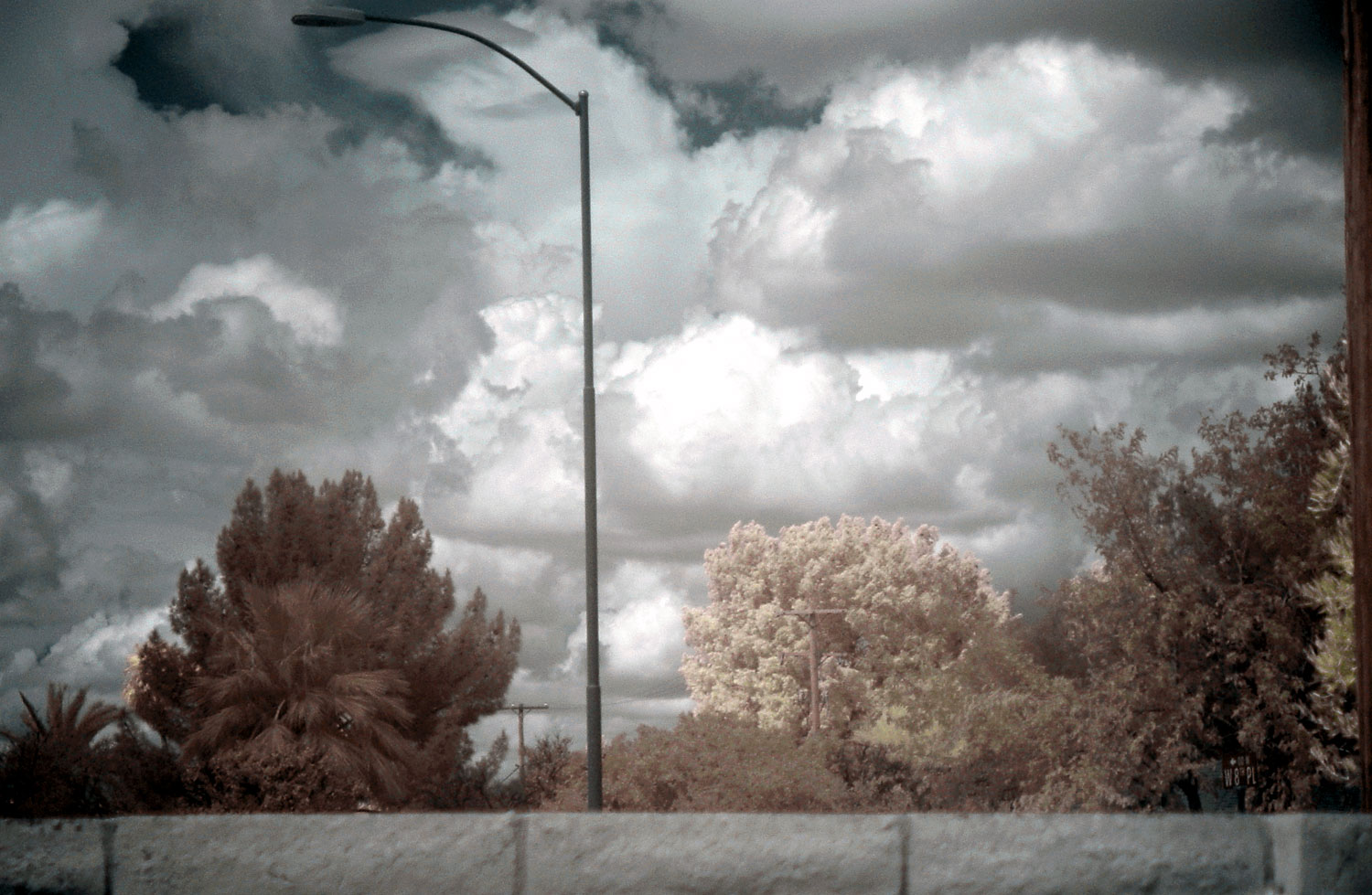
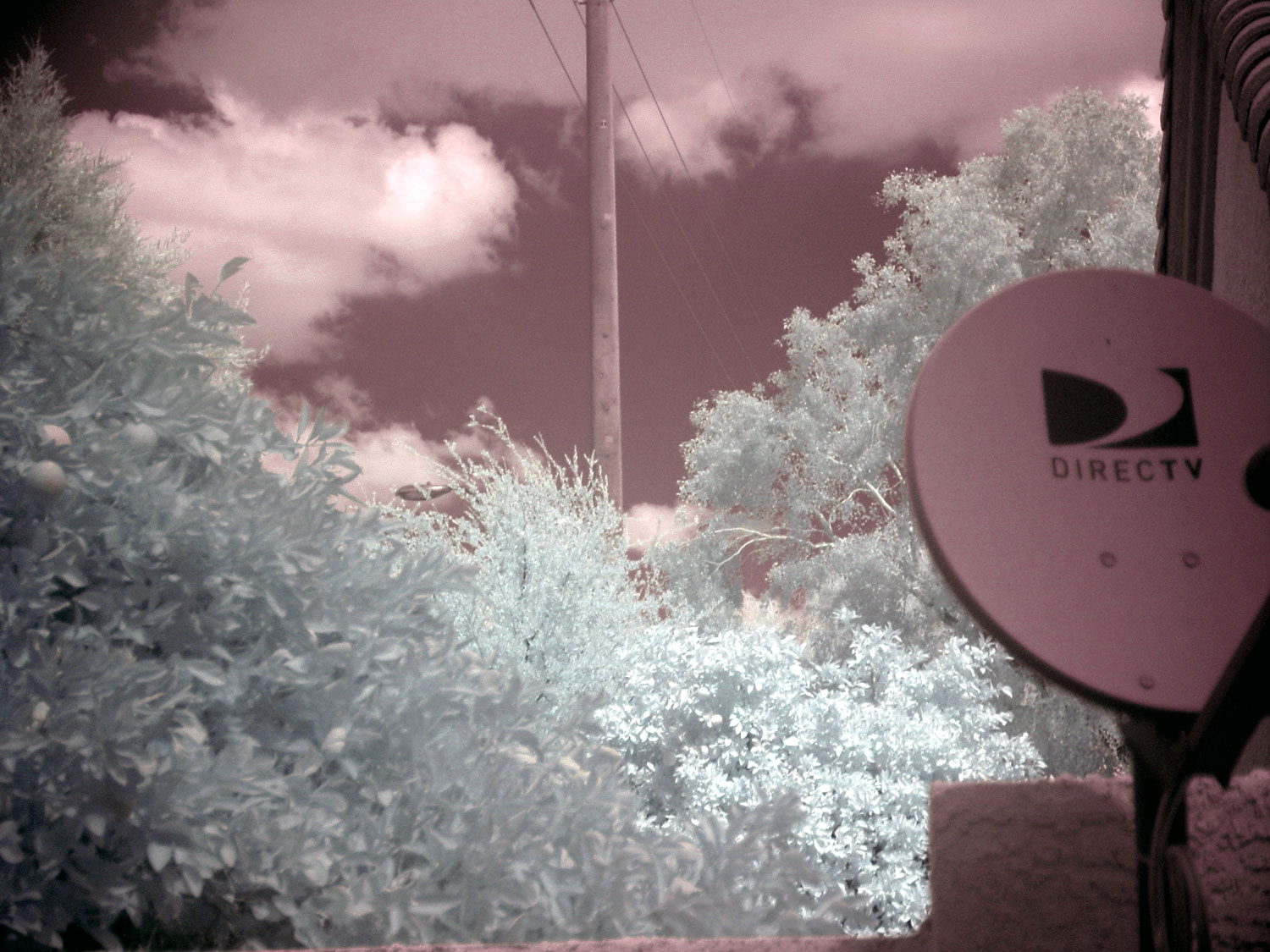
Congratulations on the camera. I hope you find what you need for IR. Can the IR filter be removed from the camera? I have an Olympus C4000 that many modify for IR by removing the IR absorbing filter. I do not have a second one to modify so my IR photography stays with my 35mm format. I think it would be interesting to mod a CCd camera though. I had tons of fun with unfiltered video cameras used for machine vision systems when I did a lot of vision system design and applications.
can you actually still find film and processing for IR 35mm? Kodak seems to have discontinued many of its IR films. From what I’ve read it seems newer digital camera sensors are less sensitive to IR than older ones, but you can still have the “hot glass” filter replaced with an IR passthrough filter in many of them and get good results (the people who do this will also update the firmware so that the autofocus works in IR frequencies). Apparently my Canon 20D is a popular candidate for this conversion as well, as people have traded up to newer models.
The neat thing about the 707 is that no conversion is needed, other than the lens filters needed to get past the crippled firmware issue. A regular digital camera with the hot glass replacement is only useful for IR from then on, where I can switch from IR back to visible light just by flipping a switch and unscrewing the filter stack. :D
Your most recent post reminded me about this one. I missed an Olympus C4000Z I was bidding on to make IR. I won’t pay more than a few dollars if I need to buy on line and pay shipping.
I have not used Kodak IR film since they quit making it and I used what I had in my freezer. I used Ilford SFX last time I shot IR (probably 5 or more years ago).
Here are some examples on Kathleen Johnson’s Blog
Yes Ir can be removed but what you dont need to do is to remove IR from Sony’s because : hese Sony models all have Real Time LCD displays, and Real Time Electronic Viewfinders. When you compose with the real time LCD or EVF, the sensor is giving you a view of what it will capture in IR Light. This is a real advantage over the cameras which use Optical Viewfinders, where you can only see the scene in Normal Color Light. IR can make dramatic changes to the view you get of a scene. Seeing it in the IR Light that will be captured is a valuable advantage. Your composition of the scene may be greatly different when you see it in IR vs seeing it in Visible Color Light. :))) Sony decides that IR is a feature what others manufacturer ( if they made this) will decide it’s a bug :D (y)
Ted, once you get an idea in your head, you are like a dog with a bone. In this case, an IR bone. Looking forward to wet synthetic fabric test-shots. Does this mean you can also measure heat signatures? I wonder how sensitive the sensor is.
Heat signatures, no. Those are beyond the 1200nm range that the F707 (and the sort of night vision goggles that SWAT teams use) can see. I think that’s “emitted IR”, where the 707 sees “reflected IR”. In it’s normal nightshot mode, the 707 has a pair of IR emitters that turn on to illuminate the scene with IR light. The kit also came with an IR flashgun for even more IR light in the dark (the specs for the flash claim it can illuminate subjects up to 60 feet away in total darkness). What I’m attempting is to use filters to allow the camera to see only reflected IR during bright daylight – less Patriot Games and more “seeing the normal daylight world in a different light”.
The result should be a semi-monochromatic vision of the world transformed into something aetherial and alien. Living things like plants and skin take on a ghostly white look, and the sky and water tend to look dark, and the end result looks something like a scene in dead winter – bitingly “cold” and sharp. Since IR is much less affected by atmospheric haze than visible light, detail and contrast become extremely sharp. Although near-IR is monochromatic, the camera’s sensor still tries to make sense of it in terms of RGB so you get *some* color information which can be enhanced into “false color” data that can turn trees and grass bright pink while retaining the blue sky. Here’s some examples:
http://www.shawn-knight.net/false-color-infrared-photography-how-to/
https://www.google.com/search?q=infrared+photography+false+color
It’s an effect that was used quite a lot by bands in the 70’s for posters and album covers (Zappa, Led Zep, etc).
Heehee it looks so cool! Can’t wait to play around with it!
Hello. This is off topic, but could you tell me what typewriter you used to type the description of the camera and how you found it? I really like the font. Do you know what it is by any chance? What pitch, etc? Thanks.
it’s the 1963 Olympia SM-7 pictured with the camera, Found at a thrift store (Deseret) for $5 earlier this year. It’s an older Olympia 12cpi Elite typeface:
http://typewriterdatabase.com/1963-olympia-sm7.1102.typewriter
http://munk.org/typecast/2013/03/25/spring-typewriter-hunting-season-bagged-3-plus-more-scans-photos-from-4th-phoenix-type-in/
Spooky images and thanks for the IR-101.
It’s funny you mention “Spooky” – one common use for IR photography is Paranormal Investigation, IE: trying to take pictures of ghosts. :D
Maybe I’ll try that this Halloween!
There is a lovely method of enabling full IR capacity of these cameras outside of nightshot mode by simply putting a magnet about 2cm from the usb port on the barrel towards the body while in nightshot then turning it to whatever mode you want.
“If you place one magnet on the spot the solenoid does not have enough power to switch the filter. So you can play around with the night shot switch.”
Not my discovery, the article is here:
http://www.jelbert.nl/?p=451
I bought a 10 x 10 x 10mm rare earth block magnet and tried it and it works 100%. If you are going to IR with these cameras its probably the best way (and combo it with IR720mn or IR850mn filters to remove the visible light spectrum).
I actually tried that, but grew tired of having a magnet taped to the lens barrel. In the end, I found it more convenient to bypass the camera’s exposure controls, set the ISO to 100 and use a cheap adjustable ND filter screwed on top of the IR filter. That way I can adjust the incoming light using the dialable ND.
I ended up getting a 720nm, an 850nm and a 950nm filter, and I’m finding that the lightest IR filter combined with medium ND gives quite nice false color effects. Surprisingly though, that improvised 5-filter stack I describe above actually gives some of the most interesting effects, and the vignetting from the undersized filters gives a very nice and pleasing softness/darkness to the edges. Sometimes you just gotta play around and see what happens. :D
You don’t mention it, but you need to block the IR light emitters that turn on in Nightshot. If you don’t the IR emitters will shine against the inside of your screw on filters causing some over exposure in your images. They are the little round glass things at about 10 and 2 o’clock on the end of the lens. A couple of squares of black electrician’s tape works fine.
Good point. I have mine covered permanently with plumber’s aluminum tape to completely block the light-emitting IR’s. If I need IR illumination, I have the hotshoe IR accessory that was sold with it.
Hi,
I have the F717, and have found that using two linear polarizers (aligned properly) and an ND8 allow me shoot during the day.
I’m considering removing the IR blocker, so that I can shoot using the colour settings, but have heard that focus becomes a problem after removing the IR blocker. Have you an experience at removing the IR blocker?
Thanks,
….. john